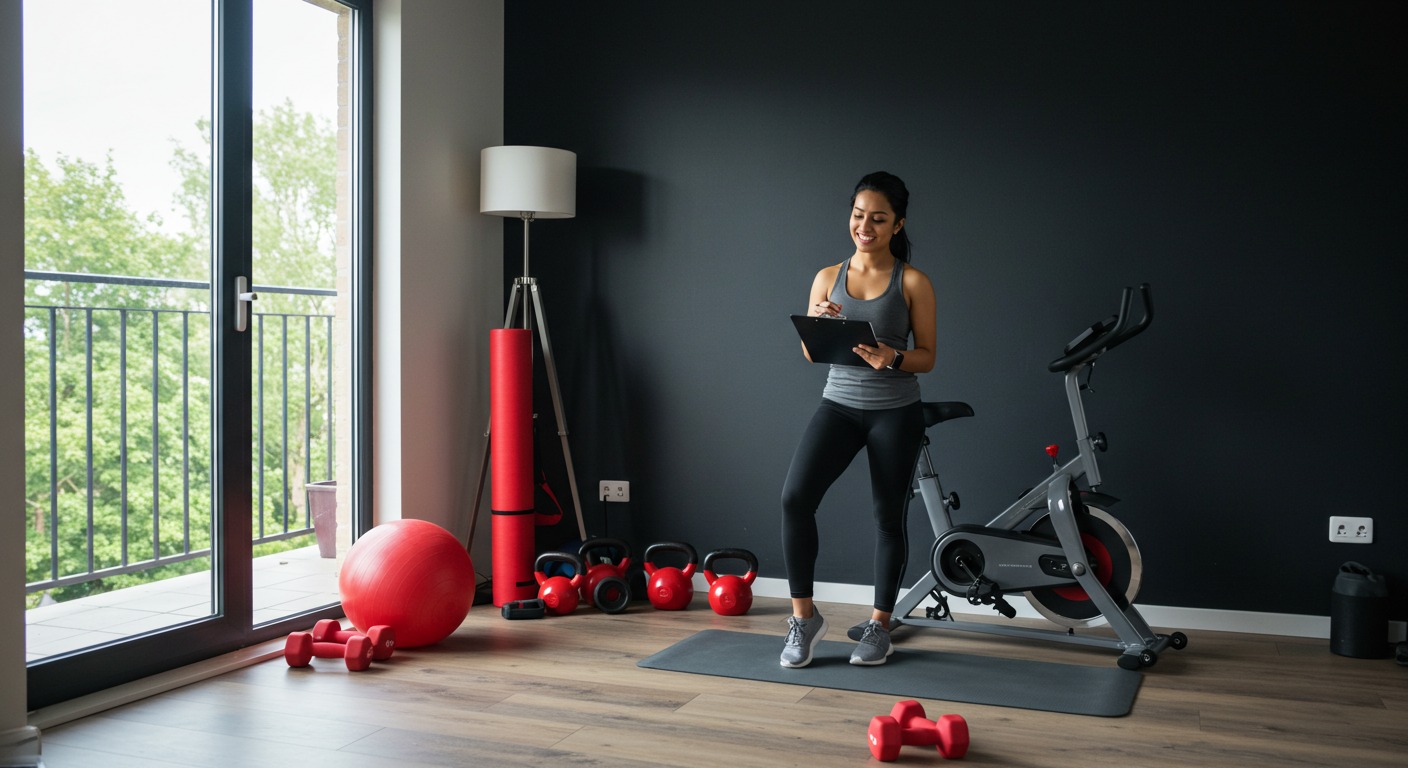Disclosure Information
This blog contains affiliate links. If you make a purchase through one of these links, our team may earn a commission at no extra cost to you. Learn more. Thanks for your support!
When your fitness progress comes to a standstill despite consistent effort, you’ve hit a workout plateau. These frustrating barriers are normal but challenging hurdles in any fitness journey.
Whether you’re strength training, running, or pursuing weight loss goals, understanding how to navigate these plateaus can make the difference between continued progress and prolonged stagnation.
Understanding Workout Plateaus
What Exactly Is a Plateau?

A plateau occurs when your body adapts to your current workout routine, resulting in diminished returns from the same exercises. This adaptation is natural—your body becomes more efficient at performing familiar movements, requiring less energy and creating less stimulus for growth or change.
According to research published in the Journal of Strength and Conditioning Research, approximately 65% of regular exercisers experience significant plateaus within six months of starting a new program.
Why Plateaus Happen
Several factors contribute to workout plateaus:
Physiological Adaptation
Your muscular system quickly adapts to repetitive stimuli. When you first begin a workout program, your body responds dramatically to the new stress. Over time, this same workout becomes your body’s new normal, and progress slows.
Neurological Efficiency
Your nervous system becomes more efficient at recruiting muscle fibers for familiar movements. While this improves performance initially, it eventually means less overall muscle stimulation from the same exercises.
Training Variables
Using the same weights, reps, and rest periods means your body faces no new challenges. Without progressive overload—gradually increasing the demands placed on your body—adaptation and growth become limited.
Nutritional Factors
Inadequate nutrition often underlies plateaus. Your caloric intake may no longer align with your fitness goals, whether you’re trying to build muscle or lose fat.
Signs You’ve Hit a Plateau

How can you recognize when you’ve hit a workout plateau? Look for these telltale signs:
- Progress measurements remain unchanged for 3-4 weeks
- Workouts feel easier but show no improvement
- Motivation begins to wane
- Recovery seems quicker than before
- Weight remains stable despite consistent effort
Science-Backed Strategies to Break Through Plateaus
1. Implement Progressive Overload
Progressive overload remains the fundamental principle for continued improvement. However, many exercisers apply it too narrowly.
Beyond Adding Weight
While adding weight is one approach, progressive overload encompasses:
- Increasing repetitions
- Extending time under tension
- Shortening rest periods
- Increasing workout frequency
- Adding complexity to movements
Recent studies show that varying your overload method produces greater long-term results than focusing solely on weight increases. The American College of Sports Medicine recommends changing overload variables every 4-6 weeks to prevent adaptation.
Implementation Strategy:
| Overload Variable | Beginner Change | Advanced Change |
|---|---|---|
| Weight | +5% every 2 weeks | +2-3% every week |
| Reps | +1-2 per set | +2-3 per exercise |
| Sets | +1 every 2 weeks | +1 weekly per group |
2. Program Periodization
Periodization—systematically varying your training program—prevents plateaus before they occur.
Linear Periodization
Start with higher repetition ranges and gradually increase intensity while decreasing volume over several weeks. For example:
- Weeks 1-3: 12-15 reps, moderate weight
- Weeks 4-6: 8-10 reps, heavier weight
- Weeks 7-9: 4-6 reps, heaviest weight
- Week 10: Recovery week with lighter loads
Undulating Periodization
Vary intensity and volume within the same week. For example:
- Monday: Heavy (4-6 reps)
- Wednesday: Moderate (8-10 reps)
- Friday: Light (12-15 reps)
A meta-analysis of 21 studies found that periodized training programs produced, on average, 25% better strength gains than non-periodized approaches.
3. Incorporate Novel Stimulus
Your nervous system responds most effectively to new challenges. Introducing unfamiliar exercises or techniques creates renewed stimulus for adaptation.
Exercise Variation
Rather than completely abandoning effective exercises, try these variations:
- Change grip position or stance width
- Switch from barbells to dumbbells
- Alter tempo (slow negatives, pause reps)
- Add bands or chains for variable resistance
Technique Focus
- Cluster sets: Short rest periods between small clusters of repetitions
- Drop sets: Performing sets to failure, then immediately reducing weight and continuing
- Supersets: Pairing exercises with minimal rest between them
- Pre-exhaustion: Isolating a muscle before using it in a compound movement
4. Optimize Recovery
Plateaus often indicate not that you’re doing too little, but that you’re recovering too poorly.
Sleep Quality
Prioritize sleep quality and quantity. Research consistently shows that sleep deprivation significantly impairs muscle recovery and growth hormone secretion. Aim for 7-9 hours of quality sleep.
Consider these sleep improvement tools:
- Blackout curtains to create optimal darkness
- White noise machines to mask disruptive sounds
- Sleep tracker to monitor sleep quality
Strategic Deloading
Incorporate deload weeks every 6-8 weeks of intense training:
- Reduce volume by 40-50%
- Maintain intensity but cut sets
- Focus on technique and movement quality
- Allow mental and physical recovery
Active Recovery
Implement active recovery between workout days:
- Light cardio (walking, swimming)
- Mobility training to improve range of motion
- Yoga or gentle stretching
- Foam rolling or massage
5. Nutrition Reassessment
As your body composition changes, so should your nutritional approach.
Caloric Recalculation
If you’ve lost significant weight, your metabolic requirements have changed. Recalculate your caloric needs every 10-15 pounds of weight change.
| Goal | Caloric Adjustment |
|---|---|
| Fat Loss | Deficit of 300-500 |
| Muscle Gain | Surplus of 250-500 |
| Maintenance | At equilibrium |
Macronutrient Timing
Strategic nutrient timing can overcome plateaus:
- Pre-workout: Moderate protein and carbohydrates
- Post-workout: Higher carbohydrates and protein
- Rest days: Higher fats, moderate protein, lower carbs
Diet Breaks and Refeeds
For those pursuing fat loss, periodic diet breaks help reset hormonal balance and reduce metabolic adaptation:
- Every 4-6 weeks, increase calories to maintenance level for 3-7 days
- Focus on increasing carbohydrates rather than fats
- Return to deficit after the break period
Advanced Plateau-Breaking Techniques

1. Blood Flow Restriction (BFR) Training
BFR involves partially restricting venous blood flow using specialized cuffs while training with lighter weights. This creates metabolic stress and can stimulate muscle growth with lighter loads—perfect for breaking plateaus or working around injuries.
2. Contrast Training
Alternate between heavy, near-maximal lifts and explosive, lighter movements of the same pattern:
- Heavy squat (85-90% 1RM) for 2-3 reps
- Jump squat with 30% 1RM for 5-6 explosive reps
- Rest 2-3 minutes
- Repeat for 3-5 sets
3. Specialized Training Blocks
Dedicate 3-4 week blocks to specific qualities:
- Strength block: Focus exclusively on lifting heavier with longer rest periods
- Hypertrophy block: Emphasize volume and time under tension
- Power block: Concentrate on explosive movements and rate of force development
Equipment Recommendations for Home Gym Plateaus
Breaking plateaus in a home gym setting requires versatile equipment that allows for progressive overload and exercise variation.
Essential Equipment
- Adjustable Dumbbells: The Core Fitness adjustable dumbbells offer quick weight changes from 5-50 pounds, allowing for seamless progression without cluttering your space.
- Resistance Bands Set: A quality resistance band set provides variable resistance that complements free weights. Use them to add tension at different points in movements or for entirely band-based workouts.
- Adjustable Bench: Look for a bench that offers multiple incline positions to vary pressing and rowing exercises. The Fitness Reality 1000 Super Max bench supports up to 800 pounds and offers 12 position adjustments.
- Pull-up Bar with Attachments: A sturdy doorway pull-up bar with different grip options allows for various back exercises. Models with attachment points for resistance bands add versatility.
Common Plateau Mistakes to Avoid

1. Program Hopping
Changing your entire program at the first sign of plateau can be counterproductive. Instead, make systematic adjustments to your existing program before abandoning it completely.
2. Excessive Training Volume
More is not always better. Adding excessive volume can lead to overtraining, which worsens plateaus rather than solving them. Focus on quality over quantity.
3. Ignoring Recovery Metrics
Pay attention to:
- Heart rate variability
- Sleep quality
- Persistent soreness
- Resting heart rate
- Mood and energy levels
These metrics provide insight into your recovery status and can guide training decisions.
4. Neglecting Technique
When progress stalls, many lifters sacrifice form for heavier weights. This not only increases injury risk but also reduces effective muscle stimulation. Sometimes, perfecting technique creates renewed progress.
Psychological Strategies for Overcoming Plateaus

1. Reset Your Benchmarks
Rather than focusing solely on traditional metrics like weight lifted or pounds lost, track different aspects of performance:
- Movement quality and range of motion
- Work capacity (total volume in a session)
- Recovery speed between sets
- Mind-muscle connection
2. Training Partners and Accountability
A training partner or coach can provide external motivation and observe changes you might miss. Consider online coaching if in-person options aren’t available.
3. Document Progress Comprehensively
Keep detailed records of:
- Workout performance
- Body measurements
- Progress photos
- Subjective feelings
- Energy levels
Sometimes progress is occurring in ways you haven’t been tracking.
Conclusion: Embracing the Plateau
Rather than viewing plateaus as failures, recognize them as signs of successful adaptation. Each plateau represents your body’s remarkable ability to adjust to demands—and each breakthrough demonstrates your capacity to evolve.
By systematically implementing the strategies outlined in this guide, you’ll develop not just a stronger physique but also greater resilience and problem-solving skills that transfer beyond your fitness journey.
Remember that consistency ultimately trumps perfection. The willingness to adapt, learn, and persist through plateaus distinguishes those who achieve lasting fitness results from those who remain stuck in cycles of frustration.



